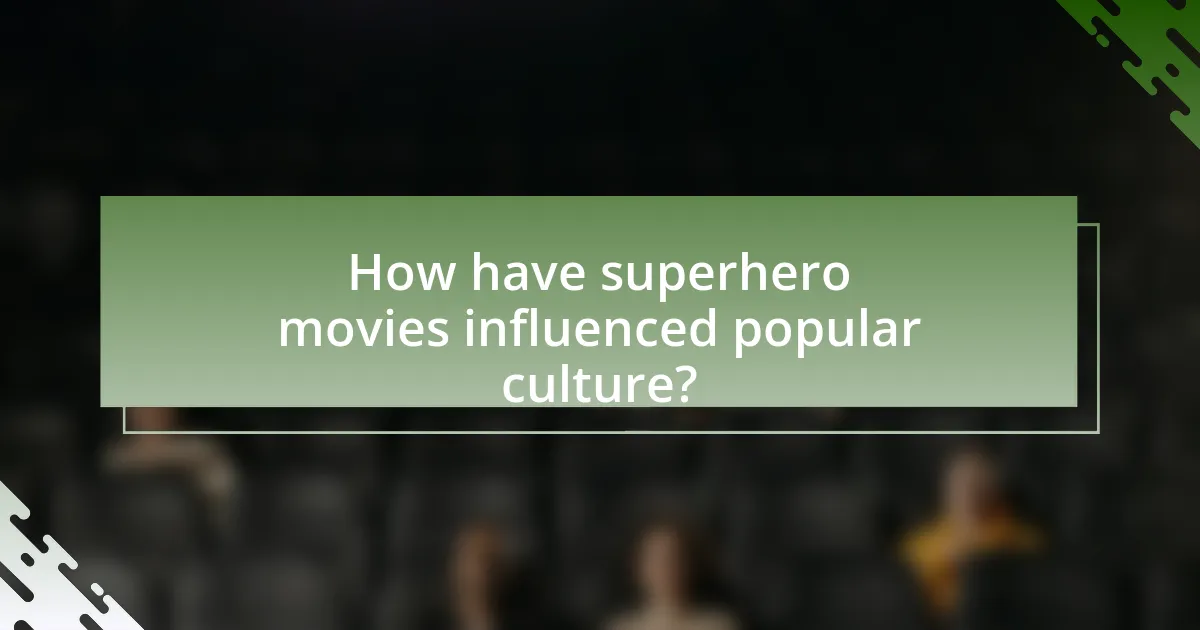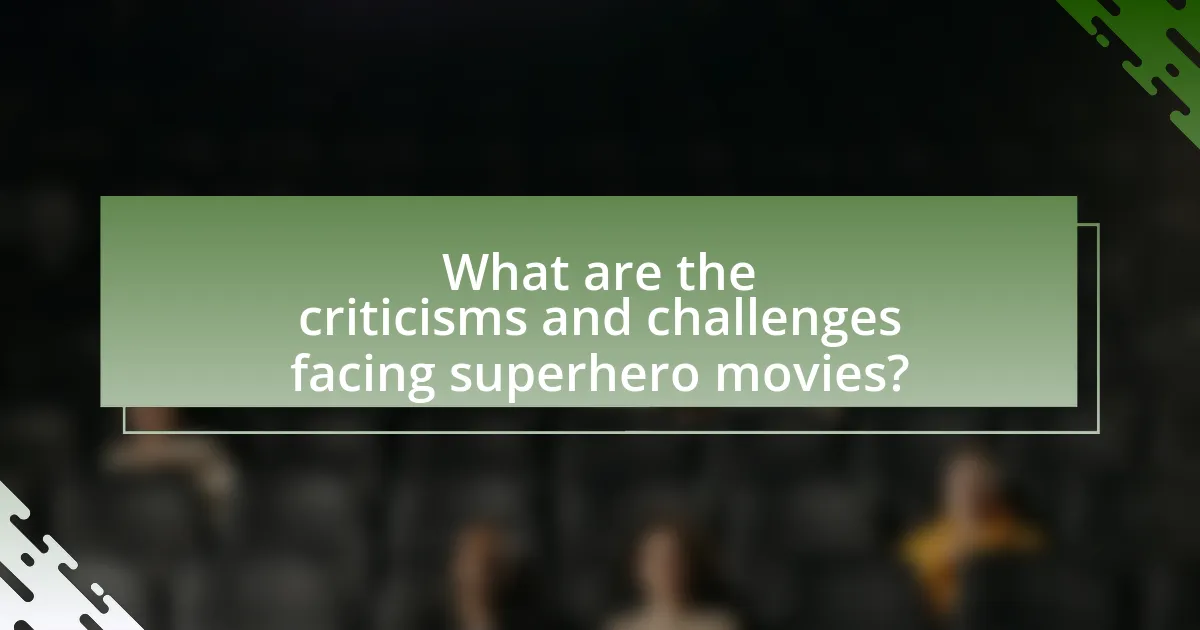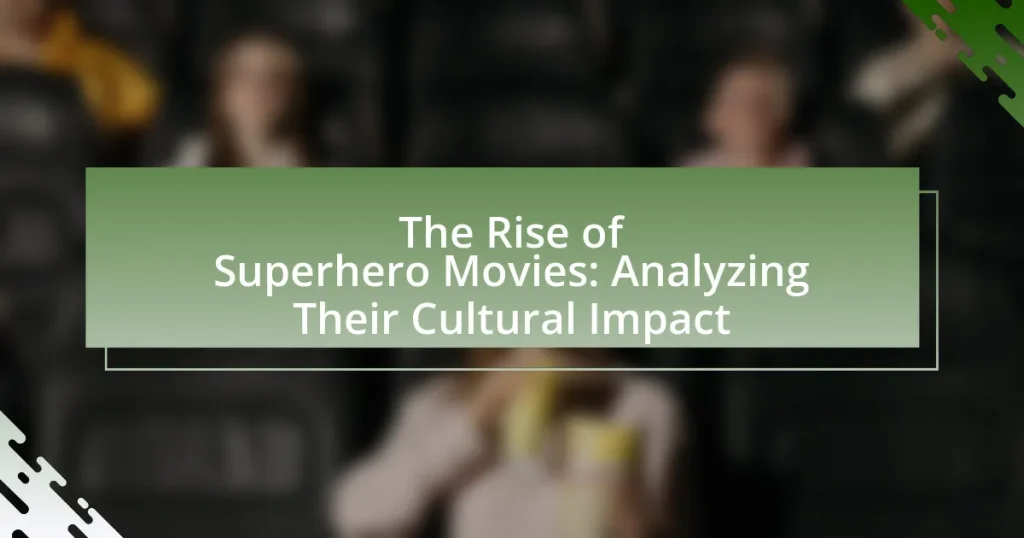The article examines the rise of superhero movies and their significant cultural impact. It identifies key factors contributing to this phenomenon, including the popularity of comic book franchises, advancements in special effects technology, and the universal appeal of superhero narratives. The article explores how comic book origins have influenced film adaptations, highlights notable characters that transitioned to the big screen, and discusses the evolution of visual styles and special effects. Additionally, it addresses audience engagement with superhero themes, societal reflections in these films, and the challenges and criticisms facing the genre, while also considering future trends and technological advancements that may shape upcoming superhero narratives.

What factors contributed to the rise of superhero movies?
The rise of superhero movies can be attributed to several key factors, including the popularity of comic book franchises, advancements in special effects technology, and the global appeal of the superhero narrative. The success of films like “Spider-Man” in 2002 and “The Dark Knight” in 2008 demonstrated the commercial viability of superhero stories, leading to increased investment in the genre. Additionally, the development of CGI and other visual effects allowed filmmakers to create more engaging and visually stunning representations of superhero powers and battles, attracting larger audiences. Furthermore, the universal themes of heroism, justice, and morality resonate across cultures, making superhero films appealing to a diverse global audience. These elements combined have significantly contributed to the sustained popularity and growth of superhero movies in contemporary cinema.
How did comic book origins influence superhero films?
Comic book origins significantly influenced superhero films by providing established characters, narratives, and visual styles that filmmakers adapted for the screen. The transition from comic books to films allowed for the exploration of complex themes such as identity, morality, and heroism, which are prevalent in comic storylines. For instance, the success of films like “Spider-Man” (2002) and “The Dark Knight” (2008) can be attributed to their fidelity to the source material, which resonated with audiences familiar with the characters’ backstories and moral dilemmas. Additionally, the visual aesthetics of comic books, including dynamic action sequences and vibrant colors, have been effectively translated into cinematic techniques, enhancing the overall viewing experience. This synergy between comic book narratives and film adaptations has led to a thriving genre that continues to evolve, reflecting cultural values and societal issues.
What are the key comic book characters that transitioned to film?
Key comic book characters that transitioned to film include Superman, Batman, Spider-Man, Iron Man, and Wonder Woman. Superman made his film debut in 1978 with “Superman: The Movie,” establishing a successful franchise. Batman first appeared in 1989’s “Batman,” which revitalized interest in superhero films. Spider-Man’s first major film was released in 2002, leading to a successful trilogy. Iron Man debuted in 2008, launching the Marvel Cinematic Universe, while Wonder Woman’s 2017 film marked a significant moment for female superheroes in cinema. These characters have become cultural icons, influencing the film industry and popular culture significantly.
How did the visual style of comics shape cinematic techniques?
The visual style of comics significantly shaped cinematic techniques by introducing dynamic framing, exaggerated action, and vibrant color palettes. Cinematic techniques such as rapid cuts, close-ups, and stylized visuals were influenced by the need to replicate the comic book experience on screen, enhancing storytelling and emotional engagement. For instance, films like “Sin City” and “300” directly adopted comic book aesthetics, utilizing high-contrast visuals and graphic novel-like compositions to create a unique viewing experience. This adaptation demonstrates how filmmakers have drawn from the visual language of comics to innovate in cinematography and editing, ultimately transforming the superhero genre and its presentation in cinema.
What role did technological advancements play in this rise?
Technological advancements played a crucial role in the rise of superhero movies by enhancing visual effects, sound design, and overall production quality. The introduction of CGI (computer-generated imagery) allowed filmmakers to create realistic and spectacular action sequences that were previously impossible, as seen in films like “Spider-Man” (2002) and “The Avengers” (2012). Additionally, advancements in digital cinematography improved the visual storytelling, making superhero narratives more engaging and immersive. The use of high-definition formats and 3D technology further attracted audiences, contributing to box office success. For instance, “Avatar” (2009), while not a superhero film, demonstrated the potential of 3D technology, influencing subsequent superhero films to adopt similar techniques. These technological innovations not only elevated the genre but also expanded its audience reach, solidifying superhero movies as a dominant force in contemporary cinema.
How have special effects evolved in superhero movies?
Special effects in superhero movies have evolved significantly from practical effects to advanced digital technologies. Initially, films like “Superman” (1978) relied heavily on practical effects, such as miniatures and wire work, to create the illusion of flight and superhuman abilities. As technology progressed, the introduction of CGI (computer-generated imagery) in the 1990s, exemplified by “Terminator 2: Judgment Day” (1991), allowed for more realistic and complex visual effects.
By the 2000s, films like “Spider-Man” (2002) and “The Avengers” (2012) showcased the seamless integration of CGI with live-action, enabling the portrayal of intricate action sequences and fantastical elements that were previously impossible. The use of motion capture technology, as seen in “Avatar” (2009), further enhanced the realism of character animations, allowing for lifelike portrayals of superheroes.
In recent years, advancements in virtual reality and real-time rendering have begun to influence the production of superhero films, providing filmmakers with tools to visualize scenes more dynamically during the shooting process. This evolution reflects a broader trend in the film industry towards increasingly immersive and visually stunning storytelling.
What impact did CGI have on storytelling in superhero films?
CGI significantly transformed storytelling in superhero films by enabling the visualization of complex narratives and characters that were previously impossible to depict. This technology allowed filmmakers to create realistic and dynamic action sequences, enhancing the emotional engagement of audiences. For instance, films like “Spider-Man” (2002) and “The Avengers” (2012) utilized CGI to bring iconic characters and their superpowers to life, which deepened the narrative experience and expanded the scope of storytelling. The integration of CGI also facilitated the portrayal of fantastical elements, such as alien worlds and superhuman abilities, making the stories more immersive and visually captivating. As a result, CGI has become a crucial tool in the evolution of superhero narratives, allowing for richer, more complex storytelling that resonates with viewers.
Why did audiences become increasingly drawn to superhero narratives?
Audiences became increasingly drawn to superhero narratives due to their ability to provide escapism and a sense of hope in challenging times. The rise of superhero films coincided with significant global events, such as the September 11 attacks and the financial crisis of 2008, which heightened the desire for stories featuring heroic figures overcoming adversity. Additionally, the expansion of cinematic universes, particularly by Marvel and DC, created interconnected storylines that engaged viewers over multiple films, fostering a sense of community and anticipation. The success of films like “The Avengers” (2012), which grossed over $1.5 billion worldwide, exemplifies this trend, demonstrating that audiences are not only entertained but also emotionally invested in these narratives.
What themes resonate with viewers in superhero stories?
Themes that resonate with viewers in superhero stories include the struggle between good and evil, the quest for identity, and the importance of sacrifice. These narratives often depict heroes facing moral dilemmas, which reflect real-world challenges, allowing audiences to connect emotionally. For instance, the conflict between heroes and villains illustrates the timeless battle of morality, while characters like Spider-Man and Batman explore personal identity and the burdens of responsibility. Additionally, the theme of sacrifice is prevalent, as seen in stories where heroes risk their lives for the greater good, resonating with viewers’ values of altruism and courage. This connection to fundamental human experiences is a key reason for the popularity of superhero narratives.
How do superhero movies reflect societal issues and values?
Superhero movies reflect societal issues and values by addressing themes such as justice, identity, and morality, which resonate with contemporary audiences. For instance, films like “Black Panther” explore racial identity and representation, highlighting the importance of diversity in media. Additionally, “The Dark Knight” delves into the complexities of morality and the consequences of vigilantism, mirroring societal debates on law enforcement and ethics. These narratives often serve as allegories for real-world challenges, such as inequality and the struggle for power, making them relevant to current social discourse.

How have superhero movies influenced popular culture?
Superhero movies have significantly influenced popular culture by shaping societal values, trends, and entertainment consumption. These films have popularized themes of heroism, justice, and morality, often reflecting contemporary social issues such as inequality and identity. For instance, the success of films like “Black Panther” has sparked discussions on representation and cultural identity, leading to increased visibility for marginalized communities in media. Additionally, the Marvel Cinematic Universe has created a shared universe concept that has transformed how franchises are developed, encouraging cross-media storytelling and fan engagement. This shift is evidenced by the rise of merchandise sales, fan conventions, and online communities dedicated to superhero narratives, illustrating their pervasive impact on modern culture.
What impact have superhero films had on fashion and merchandise?
Superhero films have significantly influenced fashion and merchandise by popularizing specific styles and creating a lucrative market for themed products. The success of franchises like the Marvel Cinematic Universe has led to the widespread adoption of superhero-inspired clothing, accessories, and collectibles, with brands like Hot Topic and Uniqlo capitalizing on this trend. For instance, the global superhero merchandise market was valued at approximately $10 billion in 2020, reflecting the strong consumer demand for products associated with these films. Additionally, collaborations between fashion designers and superhero franchises, such as the partnership between Moschino and Marvel, have further integrated superhero aesthetics into mainstream fashion, demonstrating the films’ lasting impact on both industries.
How have superhero costumes influenced everyday fashion trends?
Superhero costumes have significantly influenced everyday fashion trends by introducing bold colors, form-fitting silhouettes, and graphic designs into mainstream clothing. The popularity of superhero films, particularly since the early 2000s, has led to a rise in athleisure and casual wear that mirrors the aesthetics of superhero attire. For example, brands like Adidas and Nike have released collections inspired by superhero characters, showcasing how these costumes have permeated consumer fashion. Additionally, the rise of comic conventions and superhero-themed events has normalized the wearing of costumes and inspired streetwear that incorporates elements such as capes, masks, and emblematic logos, reflecting the cultural impact of superhero narratives on personal style choices.
What role does merchandise play in the success of superhero franchises?
Merchandise plays a crucial role in the success of superhero franchises by generating significant revenue and enhancing brand visibility. The global merchandise market for superhero franchises, such as Marvel and DC, was valued at approximately $30 billion in 2020, demonstrating its financial impact. This revenue stream not only supports film production budgets but also fosters a deeper connection between fans and the franchise through collectibles, apparel, and toys. Additionally, merchandise serves as a marketing tool, keeping the franchise relevant in popular culture and driving audience engagement beyond the cinematic experience.
How have superhero movies shaped the film industry?
Superhero movies have significantly shaped the film industry by establishing a dominant genre that influences production, marketing, and audience engagement. The success of franchises like the Marvel Cinematic Universe, which grossed over $22 billion globally as of 2021, has led studios to prioritize blockbuster films with extensive world-building and interconnected narratives. This trend has resulted in increased investment in special effects technology and a shift in storytelling techniques, focusing on serialized content that keeps audiences engaged across multiple films and platforms. Additionally, superhero films have expanded the demographic reach of cinema, attracting diverse audiences and prompting studios to explore more varied character representations and narratives.
What changes in filmmaking practices have emerged from superhero films?
Superhero films have significantly transformed filmmaking practices by popularizing the use of interconnected cinematic universes. This approach, exemplified by the Marvel Cinematic Universe, encourages studios to create franchises that span multiple films, allowing for character crossovers and shared storylines. The success of these films has led to increased investment in visual effects technology, resulting in higher production values and more sophisticated CGI. Additionally, the emphasis on global box office performance has shifted marketing strategies, with studios targeting international audiences through diverse casting and culturally relevant narratives. These changes reflect a broader trend in the industry towards franchise-driven content and enhanced viewer engagement through serialized storytelling.
How have superhero movies affected box office trends and revenue models?
Superhero movies have significantly influenced box office trends and revenue models by establishing a dominant genre that consistently generates high earnings. The Marvel Cinematic Universe, for instance, has set records with films like “Avengers: Endgame,” which grossed over $2.798 billion globally, demonstrating the financial viability of superhero narratives. This success has led to increased investment in franchise-building, with studios prioritizing sequels, spin-offs, and interconnected storylines to maximize audience engagement and revenue. Additionally, the rise of superhero films has shifted revenue models towards merchandise sales, streaming rights, and international markets, as evidenced by the global box office contributions that often exceed domestic earnings. This trend has reshaped how studios approach film production and marketing, focusing on creating expansive universes that attract diverse demographics and encourage repeat viewings.
In what ways have superhero movies influenced other media forms?
Superhero movies have significantly influenced other media forms by shaping narrative structures, character development, and visual aesthetics. The success of superhero films, particularly from franchises like the Marvel Cinematic Universe, has led to the adoption of serialized storytelling in television, where interconnected plots and character arcs mirror those found in comic book adaptations. For instance, shows like “The Flash” and “Daredevil” utilize similar episodic formats and character depth, reflecting the cinematic techniques established in superhero films.
Additionally, superhero movies have impacted video game design, with titles such as “Spider-Man” and “Batman: Arkham” series incorporating cinematic storytelling and high production values that echo the film experience. The integration of expansive universes in gaming parallels the interconnected narratives seen in superhero films, enhancing player engagement.
Moreover, the visual style of superhero movies has influenced animation and graphic novels, leading to a rise in dynamic action sequences and vibrant color palettes that were popularized by films like “The Incredibles” and “Spider-Man: Into the Spider-Verse.” This cross-pollination of styles has elevated the quality and appeal of animated content, making it more accessible to a broader audience.
In summary, superhero movies have reshaped narrative techniques, visual styles, and character development across television, video games, and animation, demonstrating their profound cultural impact on various media forms.
How have television shows adapted superhero narratives?
Television shows have adapted superhero narratives by expanding character development and exploring complex themes that are often not addressed in films. For instance, series like “Daredevil” and “The Boys” delve into moral ambiguity and the psychological impacts of being a superhero, allowing for deeper storytelling. Additionally, shows such as “WandaVision” and “The Falcon and the Winter Soldier” incorporate real-world issues like grief and identity, reflecting societal concerns while maintaining the superhero framework. This shift towards serialized storytelling enables a more nuanced exploration of characters and their motivations, which is supported by the success of these series in engaging audiences and generating critical acclaim.
What is the impact of superhero movies on video games and literature?
Superhero movies significantly influence video games and literature by shaping narrative structures, character development, and thematic elements. The success of superhero films, particularly from franchises like Marvel and DC, has led to the creation of numerous video games that mirror their cinematic counterparts, utilizing similar story arcs and character designs to attract fans. For instance, the “Batman: Arkham” series has been praised for its storytelling and gameplay, directly inspired by the character’s portrayal in films.
In literature, superhero movies have revitalized interest in graphic novels and comic books, leading to increased sales and adaptations. The popularity of titles like “Watchmen” and “Maus” has surged, as these works are often referenced in contemporary superhero films, creating a feedback loop that enhances their visibility and relevance. According to a report by the NPD Group, sales of graphic novels increased by 25% in 2020, reflecting the growing cultural impact of superhero narratives.
Overall, superhero movies have created a symbiotic relationship with video games and literature, driving innovation and expanding audiences across these mediums.

What are the criticisms and challenges facing superhero movies?
Superhero movies face several criticisms and challenges, primarily related to their formulaic storytelling, lack of originality, and oversaturation in the market. Critics argue that many superhero films follow a predictable structure, often relying on similar tropes and character arcs, which can lead to viewer fatigue. For instance, a study by the University of Southern California found that over 70% of superhero films released in the last decade share common narrative elements, diminishing their uniqueness. Additionally, the sheer volume of superhero content, with multiple franchises and sequels, has raised concerns about the diversity of cinematic offerings, potentially sidelining other genres and independent films. This oversaturation can dilute audience interest and lead to diminishing box office returns, as evidenced by the mixed reception of recent superhero films compared to earlier successes.
What are the common criticisms of superhero films?
Common criticisms of superhero films include their formulaic storytelling, lack of character development, and over-reliance on CGI effects. Critics argue that many superhero movies follow a predictable plot structure, often culminating in a climactic battle, which can lead to viewer fatigue. Additionally, character arcs are frequently underdeveloped, with protagonists and antagonists lacking depth, making it difficult for audiences to connect emotionally. The heavy use of computer-generated imagery is also criticized for overshadowing narrative substance, resulting in visually impressive but narratively weak films. These points are supported by various film critiques and audience feedback, indicating a growing concern over the creative stagnation within the genre.
How do critics view the formulaic nature of superhero storytelling?
Critics often view the formulaic nature of superhero storytelling as a limitation that stifles creativity and originality. They argue that the predictable plot structures, character archetypes, and recurring themes lead to a lack of innovation in the genre. For instance, a study published in the Journal of Popular Film and Television highlights that many superhero films follow a similar narrative arc, which can result in audience fatigue and diminished engagement. This repetitive storytelling approach has prompted some critics to call for more diverse narratives that challenge conventional tropes and explore deeper character development.
What concerns exist regarding representation and diversity in superhero films?
Concerns regarding representation and diversity in superhero films include the underrepresentation of marginalized groups and the perpetuation of stereotypes. Studies indicate that superhero films predominantly feature white male protagonists, with only a small percentage of films showcasing lead characters from diverse backgrounds. For instance, a 2020 report by the USC Annenberg Inclusion Initiative found that only 12.6% of lead roles in superhero films were held by people of color. Additionally, when characters from diverse backgrounds are included, they often fall into stereotypical roles that do not reflect the complexity of their identities. This lack of authentic representation can alienate audiences and limit the cultural impact of these films.
How are filmmakers addressing these criticisms?
Filmmakers are addressing criticisms of superhero movies by diversifying narratives and focusing on character development. For instance, recent films like “Black Panther” and “Wonder Woman” have introduced complex characters and culturally rich storylines, which counter the perception of superhero films as formulaic. Additionally, filmmakers are incorporating social issues, such as representation and identity, into their plots, as seen in “Spider-Man: Into the Spider-Verse,” which explores themes of multiculturalism and personal growth. This shift not only enhances storytelling but also engages audiences on a deeper level, demonstrating a commitment to evolving the genre in response to critiques.
What innovative approaches are being taken to diversify superhero narratives?
Innovative approaches to diversify superhero narratives include the introduction of characters from various cultural backgrounds, gender identities, and socio-economic statuses. For instance, Marvel’s “Black Panther” showcases a predominantly Black cast and explores African culture, while DC’s “Wonder Woman” emphasizes female empowerment through its titular character. Additionally, independent comics and graphic novels are increasingly featuring LGBTQ+ superheroes, such as “America Chavez” and “Midnighter,” reflecting a broader spectrum of identities. These efforts are supported by market research indicating that diverse representation can enhance audience engagement and expand viewer demographics, as seen in the success of films like “Shang-Chi and the Legend of the Ten Rings,” which grossed over $400 million globally.
How are filmmakers balancing fan expectations with creative storytelling?
Filmmakers are balancing fan expectations with creative storytelling by integrating familiar elements from source material while introducing innovative narratives. This approach allows filmmakers to satisfy established fan bases, as seen in the Marvel Cinematic Universe, where characters and story arcs are adapted from comic books, yet new plotlines and character developments keep the storytelling fresh. For instance, the film “Spider-Man: Into the Spider-Verse” successfully combined fan-favorite characters with a unique animation style and narrative structure, garnering critical acclaim and audience approval. This strategy demonstrates that filmmakers can respect fan expectations while also pushing creative boundaries, ultimately enhancing the cultural impact of superhero movies.
What can audiences expect from the future of superhero movies?
Audiences can expect superhero movies to evolve with more diverse storytelling and complex characters. As the genre matures, filmmakers are increasingly focusing on character development and social themes, reflecting contemporary issues such as identity, mental health, and inclusivity. For instance, films like “Black Panther” and “Wonder Woman” have demonstrated the commercial success and cultural significance of diverse representation, leading to a broader range of narratives that resonate with various demographics. Additionally, the integration of streaming platforms has allowed for more experimental formats and series, expanding the superhero narrative beyond traditional cinematic releases. This trend indicates a future where superhero films not only entertain but also provoke thought and discussion on societal issues.
How might evolving technology influence future superhero films?
Evolving technology will significantly influence future superhero films by enhancing visual effects, storytelling, and audience engagement. Advanced CGI and virtual reality will allow filmmakers to create more immersive and visually stunning worlds, as seen in recent films like “Avengers: Endgame,” which utilized cutting-edge technology to bring complex action sequences to life. Additionally, artificial intelligence can aid in scriptwriting and character development, enabling more nuanced narratives that resonate with diverse audiences. The integration of interactive elements, such as augmented reality experiences, can further engage viewers, making them active participants in the superhero universe. These technological advancements will not only elevate the cinematic experience but also expand the creative possibilities for filmmakers.
What trends are emerging in superhero narratives and character development?
Emerging trends in superhero narratives and character development include a focus on complex, flawed characters and the exploration of social issues. Modern superhero stories increasingly depict protagonists with moral ambiguity, reflecting real-world struggles and personal dilemmas, as seen in series like “The Boys” and “WandaVision.” Additionally, there is a growing emphasis on diversity and representation, with characters from various backgrounds and identities, such as Ms. Marvel and Black Panther, addressing themes of race, gender, and identity. This shift not only enhances relatability but also resonates with contemporary audiences, as evidenced by the success of films and shows that prioritize these elements, leading to increased box office performance and critical acclaim.
What are some best practices for engaging with superhero movies?
To engage effectively with superhero movies, viewers should prioritize understanding the source material, such as comic books, to appreciate character development and story arcs. Familiarity with the original narratives enhances the viewing experience, as many films draw heavily from established lore. Additionally, participating in discussions and fan communities can deepen insights and foster connections with other enthusiasts, enriching the overall experience. Engaging with behind-the-scenes content, such as director interviews and production documentaries, provides context that can enhance appreciation for the filmmaking process. These practices are supported by the fact that audiences who engage more deeply with the material often report higher satisfaction and enjoyment levels, as indicated by surveys conducted by film studies researchers.




